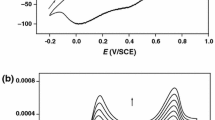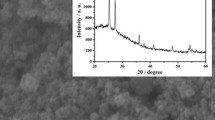Abstract
Microorganisms tend to colonize on solid metal/alloy surface in natural environment leading to loss of utility. Microbiologically influenced corrosion or biocorrosion usually increases the corrosion rate of steel articles due to the presence of bacteria that accelerates the anodic and/or cathodic corrosion reaction rate without any significant change in the corrosion mechanism. An attempt was made in the present study to protect hot-dip galvanized steel from such attack of biocorrosion by means of chemically modifying the zinc coating. W–TiO2 composite was synthesized and incorporated into the zinc bath during the hot-dipping process. The surface morphology and elemental composition of the hot-dip galvanized coupons were analyzed by scanning electron microscopy and energy dispersive X-ray spectroscopy. The antifouling characteristics of the coatings were analyzed in three different solutions including distilled water, seawater, and seawater containing biofilm scrapings under immersed conditions. Apart from electrochemical studies, the biocidal effect of the composite was evaluated by analyzing the extent of bacterial growth due to the presence and absence of the composite based on the analysis of total extracellular polymeric substance and total biomass using microtiter plate assay. The biofilm-forming bacteria formed on the surface of the coatings was cultured on Zobell Marine Agar plates and studied. The composite was found to be effective in controlling the growth of bacteria and formation of biofilm thereafter.










Similar content being viewed by others
References
Abdi-Ali A, Mohammadi-Mehr M, Alaei A (2006) Bactericidal activity of various antibiotics against biofilm producing Pseudomonas aeruginosa. Int J Antimicrob Agents 27(3):196–200
Ameer MA, Fekry AM, Shanab SM (2011) Electrochemical behavior of titanium alloy in 3.5% NaCl containing natural product substances. J Elecrochem Sci 6:1572–1585
Beech IB, Sunner J (2004) Biocorrosion: towards understanding interactions between biofilms and metals. Curr Opin Biotechnol 15:181–186
Blake DM, Maness PC, Huang Z, Wolfrum EJ, Huang J (1999) Application of the photocatalytic chemistry of titanium dioxide to disinfection and the killing of cancer cells. Sep Purif Methods 28:1–50
Dubois M, Gilles KA, Hamilton JK, Rebers PA, Smith F (1956) Colorimetric method for determination of sugars and related substances. Anal Chem 28:350–356
Fang HHP, Xu LC, Chan KY (2002) Effects of toxic metals and chemicals on biofilm and biocorrosion. Water Res 36:4709–4716
Ferin J, Oberdörster G (1985) Biological effects and toxicity assessment of titanium dioxides: anastase and rutile. Am Ind Hyg Assoc J 46:69–72
Flemming HC (2002) Mini-review—biofouling in water systems—cases, causes and countermeasures. Appl Microbiol Biotechnol 59:629–640
German RM, Ma J, Wang X, Olevsky E (2006) Processing model for tungsten powders and extension to nanoscale size range. Powder Metall 49:19–27
Gillian F, Benjamin JS, Richard DH (2007) Toxicity of titanium dioxide nanoparticles to rainbowtrout (Oncorhynchus mykiss): gill injury, oxidative stress, and other physiological effects. Aquat Toxicol 84:415–430
Hamid ZA, Aal AA, Hassan HB, Shaaban A (2010) Process and performance of hot-dip zinc coatings containing ZnO and Ni–P under layers as barrier protection. Appl Surf Sci 256:4166–4170
Jiao Y, Cody GD, Harding AK, Wilmes P, Schrenk M, Wheeler KE, Banfield JF, Thelen MP (2010) Characterization of extracellular polymeric substances from acidophilic microbial biofilms. Appl Environ Microbiol 76:2916–2922
Jones DA, Amy PS (2002) A thermodynamic interpretation of microbiologically influenced corrosion. Corrosion 58:638–645
Kangwansupamonkon W, Lauruengtana V, Surassmo S, Ruktanonchai U (2009) Antibacterial effect of apatite-coated titanium dioxide for textiles applications. Nano Med: Nano Technol, Biol Med 5:240–249
Li XZ, Li FB (2002) The enhancement of photodegradation efficiency using Pt–TiO2 catalyst. Chemosphere 48:1103–1111
Little B, Ray R (2002) A perspective on corrosion inhibition by biofilms. Corrosion 58:424–428
Mansfeld F (2007) The interaction of bacteria and metal surfaces. Electrochim Acta 52:7670–7680
Neu TR, Swerhone GDW, Lawrence JR (2001) Assessment of lectin-binding analysis for in situ detection of glycoconjugates in biofilm systems. Microbiology 147:299–313
Ornek D, Jayaraman A, Syrett BC, Hsu CH, Mansfeld F, Wood TK (2002a) Pitting corrosion inhibition of aluminum 2024 by Bacillus biofilmes secreting polyaspartate or polyglutamate. Appl Microbiol Biotechnol 58:651–657
Ornek D, Wood TK, Hsu CH, Sun Z, Mansfeld F (2002b) Pitting corrosion control of aluminium 2024 using protective films that secrete corrosion inhibitors. Corrosion 58:761–767
Peeters E, Nelis HJ, Coeny T (2008) Comparison of multiple methods for quantification of microbial biofilms grown in microtiter plates. J Microbiol Method 72(2):157–165
Rickard AH, Gilbert P, High NJ, Kolenbrander PE, Handley PS (2003) Review—bacterial co-aggregation: and integral process in the development of multi-species biofilms. Trends Microbiol 11:94–100
Sakthivel S, Shankar MV, Palanichamy M, Arabindoo B, Bahnemann DW, Murugesan V (2004) Enhancement of photocatalytic activity by metal deposition: characterisation and photonic efficiency of Pt, Au and Pd deposited on TiO2 catalyst. Water Res 38:3001–3008
Shibli SMA, Francis C (2008) Development of nano CeO2-incorporated high performance hot- dip zinc coating. Surf Coat Technol 202:4971–4975
Shibli SMA, Francis C (2011a) Development of nano TiO2-incorporated phosphate coatings on hot-dip zinc surface for good paintability and corrosion resistance. Appl Surf Sci 257:3111–3117
Shibli SMA, Francis C (2011b) CeO2–TiO2 mixed oxide incorporated high performance hot-dip zinc coating. Surf Coat Technol 205:2931–2937
Shibli SMA, Dilimon VS, Antony SP, Manu R (2006) Incorporation of TiO2 in hot-dip zinc coating for efficient resistance to biogrowth. Surf Coat Technol 200:4791–4796
Shieh KJ, Li M, Lee YH, Sheu SD, Liu YT, Wang YC (2006) Antibacterial performance of photocatalyst thin film fabricated by defection effect in visible light. Nano medicine 2:121–126
Wodka D, Bielańska E, Socha RP, Elzbieciak-Wodka M, Gurgul J, Nowak P, Warszyński P, Kumakiri I (2010) Photocatalytic activity of titanium dioxide modified by silver nanoparticles. Appl Mater Interfaces 2:1945–1953
Acknowledgments
The authors thank the Head of the Department of Chemistry and the Director of IUCGGT, University of Kerala for extending support to carry out the research work.
Author information
Authors and Affiliations
Corresponding author
Rights and permissions
About this article
Cite this article
Basheer, R., Ganga, G., Chandran, R.K. et al. Effect of W–TiO2 composite to control microbiologically influenced corrosion on galvanized steel. Appl Microbiol Biotechnol 97, 5615–5625 (2013). https://doi.org/10.1007/s00253-012-4389-1
Received:
Revised:
Accepted:
Published:
Issue Date:
DOI: https://doi.org/10.1007/s00253-012-4389-1




